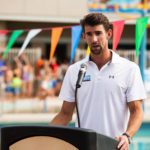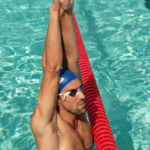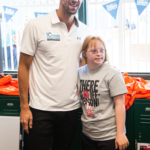Writer Shannon Severson
Photographer Bryan Black
[dropcap]W[/dropcap]hen Michael Phelps’ mother first enrolled him in swim classes at a local aquatics center in his hometown of Baltimore, Maryland, he didn’t take to it like a fish to water. In fact, he was so afraid to get his face wet that his teacher started him on his back to foster a better sense of comfort in the water. From that shaky beginning, the rest is Olympic history.
“My mom was adamant that my sisters and I learn to swim, not because she saw some competitive path of success for us, but just so we could be safe around the water,” said Phelps as he addressed a gathering organized in conjunction with the U.S. Consumer Product Safety Commission’s “Pool Safely” campaign, with his wife Nicole and youngest son, Beckett, looking on.
At just 33 years old, Michael Phelps’ name is synonymous with excellence, hard work, success and even struggle. He has parlayed his accomplishment as the all-time most decorated Olympian, with 28 medals—23 of them gold, including 13 individual gold—into a platform for community safety, promoting the sport of swimming, and advocating a healthy and active lifestyle, particularly among children.
Since moving to Arizona in 2015, Phelps has worked to directly benefit children in the Phoenix metro area.
“We love being here [in Arizona],” Phelps said. “We can’t thank the community enough for welcoming us the way it has.”
The Michael Phelps Foundation celebrates its 10th anniversary this year, having reached over 22,000 children and young adults around the world and in all 50 states with its “im” program, named for his signature event, the individual medley.
Here in Phoenix this summer, more than 1,000 children learned to swim through a partnership with Boys & Girls Club of Metro Phoenix, Special Olympics of Arizona, the City of Peoria, and Drowning Prevention Coalition of Arizona.
Phelps expressed a desire to expand the program statewide. According to DPCA President Melissa Sutton, swim classes like these reduce drowning risk by 90 percent.
Like any champion, however, Phelps isn’t satisfied.
“That number is awesome, but I’ll be the first to tell you it’s not big enough,” Phelps said. “If you’ve heard some of the [drowning] stats, we have to do more. Over the last 10 years, I feel we’ve made a very positive impact towards addressing water safety, which is also providing a great life skill curriculum.”
The new emotional skills component was born of Phelps’ personal battle with depression, which he began speaking about publicly in January of this year.
“When I first saw these 8 basic emotion charts, I was not happy when someone asked me to tell them how I felt at 6 o’clock in the morning,” Phelps explained, “but after the second or third day of them asking me, I finally realized the importance of it.”
“For me, I’m still at a point of understanding the emotions and why they’re coming up and what to do with them and how to handle them… and I’m 33. I’ve gone through a lot and I’ve dealt with a lot. I feel it’s important for a kid to understand why they’re going through something and to be able to understand that it’s OK to talk about it.
“I’m somebody who compartmentalized things for a long time and I never thought about anything. … I’m someone who has gone through a handful of pretty scary depression spells and I also understand that that’s a part of what makes me who I am. I know it’s not going to go away tomorrow, so for me, I’m just trying to continue to sharpen up the tools so that when something does happen again, I know what to do. I think to be able to teach all kids that importance at such a young age. We have a chance to save another life.”
Since becoming a father to Boomer, 2, and Beckett, 6 months, water safety has taken on an even more personal importance for Phelps. As he and Nicole recently moved into a new home, he said the first thing they did was erect a pool fence. Still, the couple had experienced a scare.
“There was a day when Boomer decided to jump in, even with Nicole there,” said Phelps. “It was a learning experience. Now he’s always checking eyes, making sure someone is around, whether it’s me or Nicole or his grandfather. Those things are so important to me.
“I can’t thank the state of Arizona and the City of Peoria enough for really being willing to jump on board with what our mission is. As you know, if you have kids, it’s something we need to take care of.
“I can’t stress it enough. Listening to the stats, it’s still frustrating. Every time I hear it, it’s upsetting. My kids are the world to me. I will not lose them.”
As of this writing, the DPCA has recorded 36 deaths in Maricopa and Pinal counties this year. Approximately 4,000 people drown in the United States each year, equating to about 10 per day. It’s the leading cause of death for children 2 and under, and the second leading cause for those 14 and under.
Here’s what you can do:
Take the Pool Safely Pledge:
A: Active Adult Supervision, meaning an adult must watch swimmers with their eyes without any distraction.
B: Barriers, including a locked fence around the pool and closed lids on toilets.
C: CPR Classes and Coast Guard-Approved Life Vests
D: Drains. Be certain that pool and spa drains comply with the Virginia Graeme Baker (VGB) Pool & Safety Act.










Comments by Admin